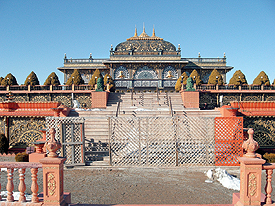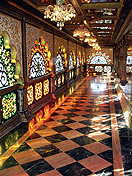Belief Still Strong at New Vrindaban
BY: STEVE NOVOTNEY

In its prime, a staff of about 1,000 members of New Vrindaban welcomed more than 100,000 tourists annually to the Palace of Gold. The Palace, once one of West Virginia’s leading tourist attractions, now welcomes between 10-15,000 visitors per year. A population of 100 devotees now reside at the Hare Krishna community.
Mar 19, CHARLESTON, WEST VIRGINIA (DAILY MAIL) — Hare Krishna: Belief Still Strong among 100 Devotees Living at Commune.
Fifteen seconds passed before Jaya Murari Dasa remembered his "first birth" age was 63. It took another 10 seconds for him to recall his "first given" name -- Joseph Moffitt -- and his central Indiana roots.
Moffitt was a plumber and father of three who came to Marshall County in 1975 to join the Hare Krishna community of New Vrindaban. Moffitt helped to build the spectacular Palace of Gold, which attracted more than 100,000 sightseers annually at its peak. Now he's confined to a wheelchair because of multiple sclerosis, an affliction he calls "a gift."
"I can now do more service to God," Moffitt explained. "One world refers to this condition as multiple sclerosis. I see it as a chance to improve my Krishna consciousness."
Belief in Hare Krishna ideals is still strong among the 100 or so devotees who remain in the once-thriving hilltop commune.
The complex is situated on 4,000 acres with six temples, 44 guest rooms, 12 cottages and the Palace of Gold.
In its heyday a quarter-century ago, the New Vrindaban community numbered more than 1,000 people.
"God made the decision to clean the house to rid this community of those who had fallen from their vows," Moffitt said. "We believe in a very spiritual life, but that wasn't the case with everyone at that time -- and that means there was not enough management taking care of the devotees. Now, he is testing us.
"The number of people here is way down compared to the number of devotees that lived here in the 1980s, but that's a positive thing because the quality of the membership is very high today.
"The scandals made us an empty container, and it allowed for those of us who remained to begin again and change the direction of this community."
The first members began arriving in the late 1960s.
In 1980, the Palace of Gold opened to the public. Built with elaborate materials from 17 countries and more than 8,000 square feet of 22 karat gold leaf trim, the palace was initially meant to serve as a residence for A.C. Bhaktivedanta Swami Prabhupada, the founder of the Hare Krishna movement.
Prabhupada, however, died in 1977 at the age of 82.

More than 8,000 square feet of 22-karat gold leaf trim and materials from 17 different countries continue to attract interest in the Palace of Gold in Marshall County.
"We used the gold because it is God's creation, and because it's nice. It looks very attractive, so that's why it was used for his residence here in West Virginia," Moffitt said. "Do men of this world not give women gold rings when they wed?
"Yes, they do, but the difference is we do not hold gold as valuable as most people in this world do. It's a memorial now for Prabhupada, and naming it the ‘Palace of Gold' was a marketing trick to get those who value materialism to come visit to satisfy their yearning."
Prabhupada's death, however, sent the global Hare Krishna community in upheaval over leadership. The result at New Vrindaban, according to Marshall County Sheriff John Gruzinskas, was corruption.
"When their leader died, there was no direction so certain folks saw it as an opportunity to move in and take advantage," said Gruzinskas, a 25-year veteran of the State Police and the lead investigator in several cases involving the activities at the commune.
"They called these people the ‘fringies' -- fringe members who were members, but not really. But the ‘fringies' were the skilled laborers doing most of the work under the table so the devotees pretty much left them alone. That was the biggest mistake they made.
"New Vrindaban was a community supporting a criminal enterprise because the ‘fringies' moved in and changed the direction. It could happen in any society. The important thing is that we don't see those things occurring today. These days, it's a whole different ballgame. They pay their county taxes, and have reported only a few problems."
No longer does Gruzinskas feel the need to travel through the New Vrindaban community on a daily basis, and the complaints registered by residents now involve trespassing and domestic violence.
"They are much more mainstream now than they were in those days. In those days they were a pretty radical group, but now they have nurses and pipefitters living there," Gruzinskas said. "That wasn't the case in the 1970s and 1980s."
That is when Gruzinskas joined federal authorities in investigating the Hare Krishna community for complaints that included copyright infringement, child sexual assaults and murder.
In 1983, devotee Charles St. Denis was reported missing by a female with whom he lived at the New Vrindaban community. Although law authorities failed to find the body or the murder weapon, an extensive investigation resulted in the conviction of Thomas Drescher for murder. He was sentenced to life in prison without mercy and is currently imprisoned at Mt. Olive.
He later was convicted of a second murder.
"What we found out was St. Denis was a big, gregarious drunk," Gruzinskas said. "He stood 6 foot 3, weighed about 230 pounds, and he used his size to get what he wanted. Everyone knew that if St. Denis was drunk, you got out of his way.
"Once we started looking for this guy, we found out that he allegedly raped another member's wife and that the man, then 31-year-old Daniel Reid, sought the advice of Swami Bhaktipada (then the commune's spiritual leader). Our investigation showed that Bhaktipada directed Reid to Thomas Drescher, and Drescher took that very seriously. That's what Reid told us, but Bhaktipada never admitted it."
Drescher's plan was to lure St. Denis to a remote cabin within the boundaries of the Hare Krishna community. St. Denis was told, Gruzinskas said, that Reid and Drescher, then 37, had purchased his favorite beer and some marijuana. When St. Denis showed up, Drescher reportedly shot him with a small-caliber handgun.
"In the end, Drescher's plan was quite ingenious. He just couldn't keep his mouth shut," Gruzinskas said. "That's how we found out a lot of the facts in the case."
Drescher was forced to use the handgun, a steak knife, a ball-peen hammer and plastic sheeting to finish off St. Denis before burying him. Drescher and Reid dammed a small stream and dug a grave in the stream bed before attacking St. Denis.
"From what Reid told us, St. Denis was still alive when Drescher put him in the hole they had dug so he used plastic to suffocate him. Once he was finally dead, they covered him up and let the dam go," Gruzinskas said.
"If Reid would not have pointed to the area several years later, the remains of St. Denis would not have been found. We brought dogs in from Connecticut, psychics from everywhere, but it wasn't until Reid showed us the area seven years after Drescher was convicted that we recovered the remains."
In 1986, the community's troubles broadened. Drescher was once again the top suspect in a murder investigation, this time in California after a disgruntled New Vrindaban member -- 33-year-old Steven Bryant -- was slain in Los Angles. Also, a West Virginia federal grand jury opened an investigation on alleged racketeering activities.
"The cases sort of merged because Drescher used a Snoopy sticker to mark Bryant's car," Gruzinskas explained. "Bryant was thought to be working on a book that would have exposed New Vrindaban for what it really was, so Drescher used a Snoopy sticker that was illegally produced at the community's print shop. Once Bryant left New Vrindaban to return to California, Drescher followed him.
"What's ironic is that the Snoopy sticker that Drescher placed on Bryant's car is what really got the ball rolling because the community produced that sticker and millions of others without permission from the creator, Charles Schultz, or his company," Gruzinskas said. "So I guess you could say that Snoopy really did get the Red Baron in the end."
Bhaktipada was finally convicted in 1996 on one count of racketeering and began serving a 12-year sentence in 1996. Bhaktipada, now 66, was released in June 2004 because of health concerns. He currently resides in New York City and remains excommunicated from the International Society of Krishna Consciousness and is not welcome at New Vrindaban.
"In my opinion, he got off easy because there were a lot of things that used to go on up there. And think about it -- there's still people who are missing who have never been found," Gruzinskas said. "If you were to go through the state's criminal code, they may have had a violation on every page.
"Their network was tremendous. They could get people in and out of there without anyone knowing. Plus, every member we talked to was singing the same song, and that's because they believe if you were not a member of the faith you were a demon. In that religion, they believe it's OK to lie to a demon -- even if he's wearing a badge."
Only 10,000 tourists visited the deteriorating Palace of Gold in 2006.
"I know they still conduct the tours, and I know they have someone who drops off the rack cards for our lobby, but that's all I've heard from New Vrindaban in a long time," said Frank O'Brien, director of the Wheeling Convention and Visitors Bureau. "We may have one or two people a month who stop by to ask directions, but there's not been a request for tour bus information for many years.
"At one time, even the people who visited Wheeling to golf wanted to make the Palace of Gold part of their visit. It's not been that way since all the troubling news started flowing out of the community."
Krishna devotee Tom Lorence arrived at New Vrindaban in 1985 and adopted the Krishna name, Tripad Dasa. He currently serves as the onsite manager of the Palace of Gold, and explained that although the structure was initially constructed for $300,000, it is now in need of more than $1 million in renovations.
"The lack of visitors is why there are areas of the palace that are in need of repair. We have closed some areas, and removed part of the structure so we don't have to deal with the liability," he said. "Our tour business has dropped off a good bit because we haven't been able to afford the advertising like we used to. But we still have some traffic -- I've even had to take a few drunks on tours.
"And we've been selling some of our land to a few members because of economics," Lorence explained. "The meaning of the word ‘Krishna' is ‘God' for us and it represents the all-attractive personality. Our beliefs still live strong here, but ever since Bhaktipada suffered his problems with the legal system, this community has struggled."
